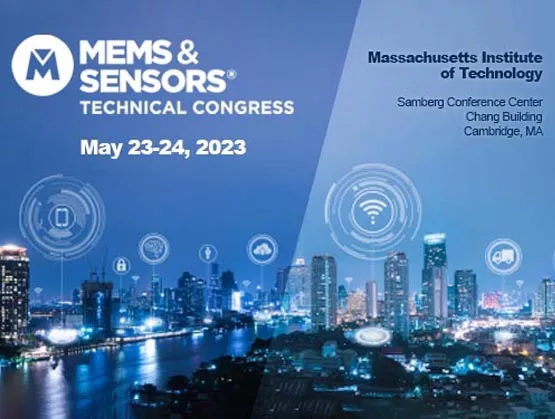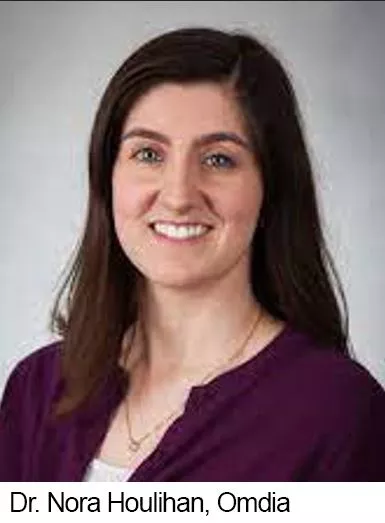
Of all technologies, MEMS and sensors stand out for their far-reaching promise to improve lives across segments such as Internet of Things (IoT), wearables, smart home, digital health, precision agriculture, autonomous vehicles, robotics, and environmental monitoring.
Little wonder, then, that the growth of the MEMS and sensor design and manufacturing industry is among the hottest topics at the annual MEMS & Sensors Technical Congress (MSTC) each year. Aptly, this year’s event – May 23-24 on the MIT campus in Cambridge, Massachusetts – will open with Nora Houlihan, senior research analyst for MEMS & Sensors with Omdia, providing a 2023 market update and a look at what’s ahead.
I caught up with Nora for a preview of her talk and to provide insight into her background.
SEMI: Do you see the recent semiconductor sector slowdown affecting MEMS market more or less than other sectors?
 Houlihan: We are seeing a bit of a slowdown in the MEMS market, especially for devices in the wireless industry (smartphones and tablets) since those are tied so closely to consumer demand. However, we do see due to strong demand in industrial, automotive, healthcare, environmental and other non-consumer electronic segments.
Houlihan: We are seeing a bit of a slowdown in the MEMS market, especially for devices in the wireless industry (smartphones and tablets) since those are tied so closely to consumer demand. However, we do see due to strong demand in industrial, automotive, healthcare, environmental and other non-consumer electronic segments.
SEMI: We continue to see some amazing MEMS applications research and product growth. What one MEMS device are you betting on for big growth in the next five years and why?
Houlihan: I expect to see significant growth in MEMS speakers in the next five years as the technology becomes less expensive and their size, range and quality advantages take hold. As MEMS continue to shrink, device designers can add devices and functionality without growing the overall size of the product. This is especially important in products such as wearables.
SEMI: Your Ph.D. research in nanoscale engineering and specifically looked into butterfly-inspired sensors. Do we have a lot to learn from animals in the sensors field?
Houlihan: We have a lot to learn from nature overall, not just in the sensor industry. Plants and animals have had millions of years to evolve so they can keep themselves cool or protect themselves from predators. They can provide inspiration for designing new sensors and nanotechnologies. I studied Morpho butterflies because they have nanostructures on their wings that are sensitive to changes in humidity, vapors, and non-condensable gases causing them to change in color.
 We can easily manufacture similar nano structures in a clean room and calibrate the sensor to whatever gas/chemical we are interested in. It is incredible to analyze and apply the same thinking to our manufactured sensors. There is a nearly inexhaustible list of other nature-based research that could be done. We humans have barely scratched the surface.
We can easily manufacture similar nano structures in a clean room and calibrate the sensor to whatever gas/chemical we are interested in. It is incredible to analyze and apply the same thinking to our manufactured sensors. There is a nearly inexhaustible list of other nature-based research that could be done. We humans have barely scratched the surface.
SEMI: Do you think we have a good balance of start-ups vs. large companies in the MEMS sector?
Houlihan: Yes, it’s exciting to see some of the new technologies that are coming out of startups, which rely on the larger companies to take their innovations to market or are scaling that wall themselves. Thanks to events like MSTC, the smaller companies get the opportunity to reveal their work and bolster get support they need to continue to innovate.
SEMI: Any other conversation topics you would like to have with other sensor technology experts during MSTC?
Houlihan: I am looking forward to getting more details on how IoT is impacting the MEMS industry. Several years ago we were expecting big numbers – I recall a Trillion Sensors Initiative – and would like to discover how that is playing out in reality. With the number of embedded sensors and ubiquity of sensor platforms, it could very well be realized.
SEMI: On the personal side, do you prefer a beach or mountain vacation?
Houlihan: Mountain vacation! I grew up hiking and camping in the Adirondacks. I love to see all the trees change color in the fall.
See the MSTC 2023 agenda and register!

The SEMI MEMS and Sensors Industry Group (MSIG) is a leading group of 180+ ecosystem-wide companies that collaborate and share ideas to help accelerate the adoption of MEMS and sensors into products and services. MEMS and sensors play an integral role in billions of electronic devices. From your smartphone to your smart home, MEMS and sensors are the essential enabling components that allow people to experience the world around them in fundamentally new ways. SEMI MSIG, led by Executive Director Tim Brosnihan and Senior Director Paul Carey, is determined to help sensorize the world! Learn more about SEMI MSIG.
About Dr. Nora Houlihan
Dr. Nora Houlihan is a Senior Research Analyst, focusing on MEMS and sensors as part of the Omdia Components & Devices market pillar.
Houlihan joined Omdia in the spring of 2022. Previously, she was an adjunct instructor at The Citadel in Charleston, South Carolina, where she taught in the chemistry department. Houlihan has a Ph.D. in nanoscale engineering from SUNY Polytechnic Institute in Albany, New York. She also has a Bachelor of Science in chemistry from Clarkson University in Potsdam, New York.
Timothy Brosnihan is Executive Director of the MEMS and Sensors Industry Group (MSIG) at SEMI.